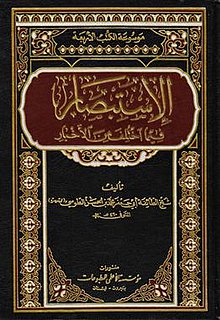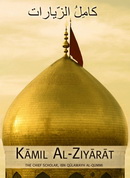 W
WAl Ghadir is a 20-volume book written by the Iranian Shia scholar Abd Al Husayn Amini.
 W
WAl-Istibsar is a Hadith collection, by the famous Twelver Shia Hadith scholar Abu Jafar Muhammad Ibn Hassan Tusi, commonly known as Shaykh Tusi. This work is included among The Four Books of Shia Islam. It includes the same subjects as Tahdhib al-Ahkam but in a shorter form.
 W
WThe Book of the Sage and Disciple is a religious narrative of spiritual initiation written in the form of a dramatic dialogue by Ja'far ibn Mansur al-Yaman. The work describes the encounter of a disillusioned young man with a dā‘ī, or Isma'ili Muslim missionary, who gradually introduces his new disciple to the inner dimensions of Islam as elaborated by the Shi'a imāms.
 W
WOur Economy is a major work on Islamic economics by prominent Shia cleric Muhammad Baqir al-Sadr. Muhammad Baqir Al-Sadr was born on Kadhimiyeh, Baghdad in 1935. The book was written between 1960 and 1961, and published in 1982. It is al-Sadr's main work on economics and one of his most significant works, and still forms much of the basis for modern Islamic banking. The first translation into English was done in 1982 by the Iranian government and after that the book was translated into German in 1984 by a young German orientalist.
 W
WKalīla wa-Dimna is a book containing a collection of fables. It was translated into Arabic in the Abbasid age specifically in the second hijri century by Abdullah ibn al-Muqaffa using his own writing style. A lot of researchers have agreed that the book goes back to Indian roots, and was based on the Sanskrit text Pañcatantra. Then it was translated into Pahlavi language at the beginning of the sixth Gregorian century by orders from Khosrow I.
 W
WKamil al-Ziyarat is a Hadith collection of 843 traditions, by the famous Twelver Shia Hadith scholar Abul-Gasem Jafar b. Mohammad b. Jafar b. Musab Qulawayh Qumi Bagdadi, commonly known as Ibn Qulawayh.
 W
WKingdom of the Vision is an economics book by Abdullah Al-Salloum. The book, subtitled "Within the Conflicts of Sustainability and Rent", ISBN 978-0692144862, extensively elaborates on Saudi Arabia's Vision 2030; linking its strategy to macroeconomics theories. The title was ranked as best-seller on Jamalon – the Middle-East's largest online book retailer –, Jarir Reader – Middle-East's largest e-book store –, and Amazon's Arabic books category.
 W
WThe Kitāb ṣalāt al-sawāʻi is widely considered the first book in Arabic printed using movable type. It was a book of hours intended for Arabic-speaking Christians and presumably commissioned by Pope Julius II. It had 120 unnumbered pages. Some eight or nine copies are known to survive.
 W
WKuwait of the Sustainability is a political economic book by Abdullah Al-Salloum. The book, subtitled "Vision of a people, from and to them.", ISBN 978-1732537538, extensively highlights the Kuwaiti economy in particular, aiming at clarifying the concept of sound economic vision through radical solutions targeting macro-economic issues of the state.
 W
WThe Nahj al-Balagha is the most famous collection of sermons, letters, tafsirs and narrations attributed to Ali Ibn Abi Talib, cousin and son-in-law of Muhammad. It was collected by Ash-Sharif Ar-Radhi, a Shia scholar in the 10th century AD Known for its eloquent content, it is considered a masterpiece of literature in Shia Islam.
 W
WPeople and dogs is a collection of short stories written by the Egyptian physician Moawad GadElrab and published by The National Publishing and Printing house in Cairo, Egypt 1964.
 W
WSaving Hope: The Long Way to the Arab Spring is a 2013 non-fiction book by Bahraini cultural critic Nader Kadhim. Written in Arabic, it is the ninth book by Kadhim, who works as a Professor of Cultural Studies at the University of Bahrain. Written in two stages, before and during the Arab Spring, the book discusses this wave of protests from two sides; the past and the future. The past is divided into three waves, each of them corresponding to an era of hope and aspiration. First is the enlightenment wave, followed by the revolutionary wave and finally the democratic wave. The author then tackles the Arab Spring and argues that it is not the time for celebration, but an important station in the long way towards democracy.
 W
WTahdhib al-Ahkam (Tahdhib al-Ahkam fi Sharh al-Muqni'ah) is a Hadith collection, by Twelver Shia Hadith scholar Abu Ja'far Muhammad Ibn Hasan Tusi, commonly known as Shaykh Tusi. This work is included among the four books of Shia Islam. It is a commentary on the Al-Muqni'ah by Al-Shaykh Al-Mufid, who was a Twelver Shia theologian.
 W
WTahrir al-Wasilah is a book by Ayatollah Khomeini as a commentary on a traditional theological text, and as a guide for Shia Jurists on the opinions of Khomeini.
 W
WThe Voice of Human Justice (ISBN 978-964-438-158-4) is an English translation of Sautu'l 'Adālati'l Insaniyah, a book written in Arabic by George Jordac, a Christian author from Lebanon. The book is a biography of Ali ibn Abi Talib. The contents of the book were drawn from the Nahj al-Balagha of Ali.